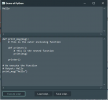Easily Learn Python Closures With A Delphi Windows GUI App
February 3, 2021 by Muhammad Azizul
A Closure in Python is a function object that remembers values in enclosing scopes even if they are not present in memory.
Prerequisites: Before we begin to work, download and install the latest Для просмотра ссылки Войдиили Зарегистрируйся for your platform. Follow the Для просмотра ссылки Войди или Зарегистрируйся installation instructions mentioned Для просмотра ссылки Войди или Зарегистрируйся. Alternatively, you can check out the easy instructions found in this video Для просмотра ссылки Войди или Зарегистрируйся.
First, open and run our Python GUI using project Demo1 from Python4Delphi with RAD Studio. Then insert the script into the lower Memo, click the Execute button, and get the result in the upper Memo. You can find the Demo1 source on Для просмотра ссылки Войдиили Зарегистрируйся. The behind the scene details of how Delphi manages to run your Python code in this amazing Python GUI can be found at this Для просмотра ссылки Войди или Зарегистрируйся.

Open Demo01.dproj
A function defined inside another function is called a nested function. Nested functions can access variables of the enclosing scope.
In Python, these non-local variables are read-only by default and we must declare them explicitly as non-local (using nonlocal keyword) in order to modify them.
Following is an example of a nested function accessing a non-local variable in Python GUI:
Output in Python GUI:

Simple Example of Nested Function in Python GUI.
The call to makeInc creates a binding for x that is referenced inside the function inc. Each call to makeInc creates a new instance of this function, but each instance has a link to a different binding of x. See the output in the Python GUI below:

Simple Example of Closures in Python GUI.
Notice that while in a regular closure the enclosed function fully inherits all variables from its enclosing environment, in this construct the enclosed function has only read access to the inherited variables but cannot make assignments to them:
Output in Python GUI:

The Enclosed Function has only Read Access to the Inherited Variables but cannot Make Assignments to them.
The criteria that must be met to create closure in Python are summarized in the following points.
Closures can avoid the use of global values and provides some form of data hiding. It can also provide an object oriented solution to the problem.
When there are few methods (one method in most cases) to be implemented in a class, closures can provide an alternate and more elegant solution. But when the number of attributes and methods get larger, it’s better to implement a class.
Для просмотра ссылки Войдиили Зарегистрируйся
February 3, 2021 by Muhammad Azizul
A Closure in Python is a function object that remembers values in enclosing scopes even if they are not present in memory.
- It is a record that stores a function together with an environment: a mapping associating each free variable of the function (variables that are used locally, but defined in an enclosing scope) with the value or reference to which the name was bound when the closure was created.
- A Closure—unlike a plain function—allows the function to access those captured variables through the Closure’s copies of their values or references, even when the function is invoked outside their scope.
Prerequisites: Before we begin to work, download and install the latest Для просмотра ссылки Войди
First, open and run our Python GUI using project Demo1 from Python4Delphi with RAD Studio. Then insert the script into the lower Memo, click the Execute button, and get the result in the upper Memo. You can find the Demo1 source on Для просмотра ссылки Войди

Open Demo01.dproj
1. Non-Local Variable in a Nested Function
Before reviewing deeper into what a Python Closure is, we need to understand what is a nested function and nonlocal variable first.A function defined inside another function is called a nested function. Nested functions can access variables of the enclosing scope.
In Python, these non-local variables are read-only by default and we must declare them explicitly as non-local (using nonlocal keyword) in order to modify them.
Following is an example of a nested function accessing a non-local variable in Python GUI:
Python:
def print_msg(msg):
# This is the outer enclosing function
def printer():
# This is the nested function
print(msg)
printer()
# We execute the function
# Output: Hello
print_msg("Hello")
Simple Example of Nested Function in Python GUI.
2. Python Closures
Closures in Python are created by function calls. Here is the example:
Python:
def makeInc(x):
def inc(y):
# x is "attached" in the definition of inc
return y + x
return inc
incOne = makeInc(1)
incFive = makeInc(5)
print(incOne(5)) # Prints 6
print(incFive(5)) # Prints 10
Simple Example of Closures in Python GUI.
Notice that while in a regular closure the enclosed function fully inherits all variables from its enclosing environment, in this construct the enclosed function has only read access to the inherited variables but cannot make assignments to them:
Python:
def makeInc(x):
def inc(y):
# Incrementing x is not allowed
x += y
return x
return inc
incOne = makeInc(1)
incOne(5)
# UnboundLocalError: local variable 'x' referenced before assignment
The Enclosed Function has only Read Access to the Inherited Variables but cannot Make Assignments to them.
3. When do we have Closures in Python?
As seen from the above example, we have a closure in Python when a nested function references a value in its enclosing scope.The criteria that must be met to create closure in Python are summarized in the following points.
- We must have a nested function (function inside a function).
- The nested function must refer to a value defined in the enclosing function.
- The enclosing function must return the nested function.
4. When to use Closures in Python?
So what are closures good for?Closures can avoid the use of global values and provides some form of data hiding. It can also provide an object oriented solution to the problem.
When there are few methods (one method in most cases) to be implemented in a class, closures can provide an alternate and more elegant solution. But when the number of attributes and methods get larger, it’s better to implement a class.
Для просмотра ссылки Войди
